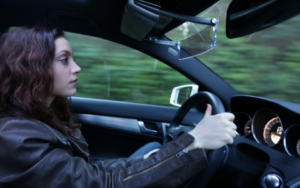We had a chance to talk to RR Technologies (Vancouver, Canada) recently about their new automotive Heads-up Display (HUD) called Iris. It is the first visor-based HUD we have heard about and will be an after-market product that connects to your smartphone and costs only $499.
HUDS positioned at the top of the user’s field of view are common in avionic HUD applications, but not automotive, so the position seems quite natural, actually (as we reported in our Latin Display missive, automotive applications often follow a few years behind aviation – Man. Ed.). According to co-founder Dallas La Porta, they initially started development two years ago on a dashboard-mounted HUD but decided this was not the way to go. For one thing, there are so many dashboard configurations that a universal mount would be needed. This ends up positioning the HUD pretty high up in the field of view, which can block your view directly in front of the car – not a good thing if a child or animal runs out in front of you.
The visor position is much more universal and is mounted to the roof of the car. The combiner then extends down from the roof to fill part of the upper part of the windshield on the driver’s side. As illustrated in the photo, the combiner can fold up between the two arms and retracted toward the base to be almost fully out of the way when not in use. La Porta says they have tried this on several cars including a BMW, Honda and Mercedes without any issues.
The Iris Heads Up Display from DD Technologies
As for the technology driving the HUD, La Porta could only say that it is a MEMS-based laser scanner that can scan red, green and blue light on the combiner. Note that the combiner has curvature to create a virtual image that hangs somewhere out over the hood of the car. The image resolution is 1200×360 and appears to create an image that is about 12” wide. The current product produces about 25 lumens but the next one will move to 40 lumens – which is plenty of light according to La Porta. He also says they are improving the lenses too, to sharpen up the image some more.
The position also has advantages from a usability point of view to. For example, the display of icons and text can sometimes get lost in the background with more conventional HUD where the image is in the lower half of the drivers field of vision. Looking up to see the HUD symbology usually means you are looking at a more uniform and less clutter background, making it easier to see what you are looking at.
When I mentioned that this position is favored in aircraft, La Porta acknowledged that they did not know this when they focused on it, but at CES they heard from a number of companies that would be interested in placing this in an aircraft. That makes a lot of sense as aircraft HUDs are very expensive and this is definitely worth trying. Toward that end, they are now working on a small adapter.
Content will come from your mobile device and will be transferred via Bluetooth. They have developed an app for this and have developed a novel gesture control scheme as well. It is quite simple really: you wave your finger toward the outside of the car to get rid of something and toward the car to bring something on-screen. This uses a simple proximity sensor.
The app will be offered as an open source platform to facilitate development of additional apps. One example La Porta cited was to allow developers to take tire pressure sensor data and display that on the HUD. Iris is compatible with iOS and Android
On the company’s website, there is a video showing the HUD in action. It is worth taking a look. It shows the display of text message headings and caller IDs and can integrate with navigation software to give directions, speed and other parameters – even warning about cross walks and if you are speeding.
The company has self-funded development so far, but will soon launch a crowd funding campaign on Indiegogo where the first units will be offered for $399. They are only seeking $100K on Indiegogo but are also looking for strategic investors. Their tooling is nearly ready to go and they have an Asian manufacturer lined up that can easier produce 50K per year. They have two optics providers in addition to the laser scanning supplier as well. New funds will be used to develop and execute a marketing plan and retail distribution strategy.
Display Daily Comment
This looks like a refreshing new approach to an aftermarket HUD that may actually be quite useful. – CC

